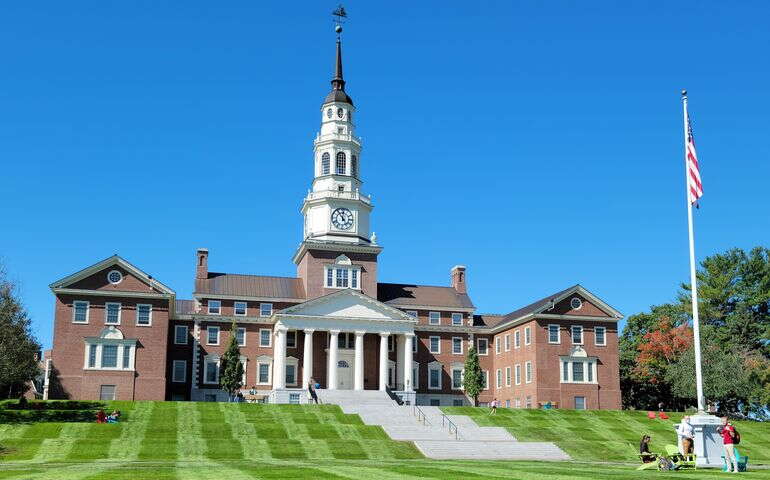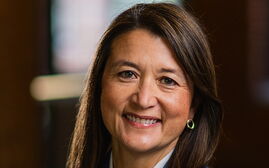
Maine's 'Little Ivies' dismiss national rankings for economic diversity as outdated, misleading
 Courtesy / Bates College, Phyllis Graber Jensen
More than 40% of Bates College students receive need-based financial aid, according to a spokeswoman for the Lewiston private liberal arts institution.
Courtesy / Bates College, Phyllis Graber Jensen
More than 40% of Bates College students receive need-based financial aid, according to a spokeswoman for the Lewiston private liberal arts institution.
Three of Maine’s top colleges are dismissing poor marks they've received for the economic diversity of their student bodies, claiming a recent evaluation by the New York Times is outdated and misleading. All three say they’re admitting more students from low-income backgrounds.
Out of 286 of the country’s most selective colleges ranked by the newspaper, Bates College in Lewiston tied with three others in last place, No. 283. Colby College in Waterville was No. 230 and Bowdoin College in Brunswick was No. 207.
The three schools, all of which placed in the country's top 25 liberal arts institutions in the latest U.S. News & World Report rankings released Monday, are sometimes referred to as Maine’s “Little Ivies.”
But on the New York Times list of competitive schools with the greatest economic diversity, released Sept. 7, the trio came in well below two other Maine schools, Bar Harbor's College of the Atlantic (No. 32) and the University of Maine (No. 64).
Those standings were based on the proportion of the 2020-21 freshman class in each institution that received federal Pell Grants, which typically go to students at the bottom half of the income spectrum.
Representatives of Bates, Bowdoin and Colby all told Mainebiz that while Pell numbers are just one measure of economic diversity, the schools have made progress since 2020.
It's not immediately clear how the percentages of Pell Grant recipients at schools nationwide may have also changed since then.
'Bates is need-aware'
The New York Times study showed that only 8% of 2020-21 freshmen at Bates received Pell Grants.
“Since then, we have moved the needle significantly,” with 12.4% of incoming 2022 freshmen Pell-eligible, “more closely in line with many peer institutions,” Bates College spokeswoman Mary Pols said.
Looking ahead, “Bates is absolutely vested in attracting and enrolling more Pell-eligible students,” she added. “We are not yet where we want to be with our Pell Grant enrollments, but we are confident that we will continue to make gains.”
She also said that more than 40% of Bates students receive need-based financial aid, and that the school is one of only 75 colleges in the country to meet the full demonstrated financial need of every student admitted.
“Bates is need-aware in its admission process,” Pols said. “We recognize higher education is an investment and understand the financial challenges families face in managing costs. This is why we offer strictly need-based financial aid to eligible admitted students, and why we meet 100% of the calculated need of our students.
"We recognize that each family’s circumstances are different, and for that reason, we encourage any family concerned about paying for college to apply for institutional need-based financial aid.”
Every year, the Lewiston school grants more than $40 million in financial aid, with an average package — including grants, loans and work — of more than $58,000 for the class of 2027.
Beyond financial support, Bates promotes diversity through initiatives including programming for first-generation college students; a STEM Scholars program that seeks to attract more underrepresented students to science, technology, engineering and math; and, for faculty members, a Center for Inclusive Teaching and Learning.
“Our work to create a welcoming and inclusive environment starts with Admission and Student Financial Services and continues throughout our students’ four-year experience on campus,” Pols said. “We have a set of resources that support the unique needs of various student populations, particularly groups that were historically underrepresented in higher education.”
Bowdoin’s ‘holistic admissions’
Bowdoin’s No. 207 ranking was based on a ratio of 16% Pell Grant proportion for the 2020-21 freshman class.
That proportion has gone up to 19% for the class just matriculated, “and we are committed to increasing the percentage further in the years ahead,” spokesman Doug Cook said.
At the same time, because Pell Grants are available only to domestic students, international students are not included in the New York Times rankings even though they represent a diverse perspective and different economic levels, he said.
Since 2017, the school has joined the American Talent Initiative and committed to growing its share of Pell-eligible students in its first-year classes and to providing an opportunity for community college students through the Transfer Scholars network.
“That commitment can be seen in our most recent classes, which are not part of the data utilized in the Times analysis,” Cook said. He also noted that as changes to the Federal Application for Student Financial Aid are implemented by the Department of Education this year and next, Pell Grant eligibility will change as well.
“For Bowdoin, economic diversity means more than simply enrolling students from the extreme ends of the spectrum,” he said. “Bowdoin aims to represent middle-class students as well as low-income students in its classes.”

Bowdoin is also a need-blind institution, including for international students, meaning that admissions decisions are made without income information about the applicant.
“While we certainly pay attention to a student’s lived experience within our holistic admissions process to recognize the context in which a student has grown up,” Cook said, "income has not been a factor.”
Out of this year’s freshman class, 51% receive need-based financial aid, with an average grant amount of $61,050. Every entering student at Bowdoin also receives a MacBook Pro and a suite of software when they matriculate through the school’s Digital Excellence Commitment, launched in 2022.
“This evens the digital playing field for all of our students,” Cook said.
Colby’s ‘ongoing success’
At No. 230 on the New York Times list, Colby had a 2020-21 freshman class of which 14% were Pell recipients.
That proportion has gone up in the meantime to 16% for the incoming fall class, while 18% of first-year students will be the first in their families to attend and graduate from college, according to the school.
“Economic diversity is more complex than simply counting Pell recipients, and Pell Grants only tell a small part of diversity at Colby College,” the school said in an emailed response to Mainebiz.
“They are convenient to use because they come from a government database but they don’t reflect Colby’s ongoing success in increasing the economic diversity of its community.”
The school also underscored that, unlike most colleges, it has also provided generous aid packages to extremely low-income students from many countries around the world who would be eligible for Pell Grants if they were U.S. citizens.
From 2014 to 2022, Colby increased the number of first-generation-to-college students by 44% and more than doubled the number of Pell-eligible students, according to the school.
Colby also noted that from 2014 to 2023, the school has more than doubled its financial aid budget “so that a Colby education is attainable to talented students of all backgrounds.”
School-specific financial aid programs include Colby’s Fair Shot Fund, which guarantees that families earning up to $150,000 with typical assets can expect an annual parent or guardian contribution of $15,000 or less, often making the cost of attendance less than a public institution, according to the school.
“This is an especially important program because it supports students from families who are often the ones left behind in terms of having access to private colleges,” Colby College said in its email.
The school also noted that out of 286 colleges evaluated by the New York Times, Colby’s net price for both low- and middle-income students was one of the lowest.
“Colby also pledges to meet 100% of each admitted students’ demonstrated financial need without loans,” it said.















0 Comments